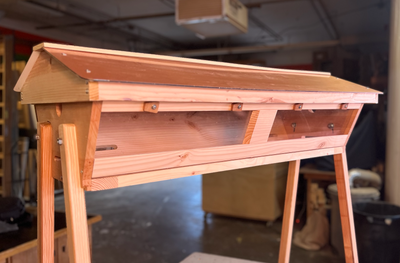Once you’ve read up on what it takes to begin beekeeping, it’s time to decide which hive type you’d like to use.
Top Bar Hives are satisfying to manage, require no heavy lifting (a full bar of honey weighs 5-7 lbs), teach you a lot about bees, require the most regular management, but generally yield the least amount of honey of the three types of hives we offer.
HISTORY
Top Bar Hives are one of the oldest hive types. Modern designs have evolved from felled logs in nature being populated by feral colonies. Humans realized if they placed sticks across a cavity, they could pull the comb out, making it easier to harvest.
The Peace Corps standardized modern designs in the 1970s.
HOW TO TOP BAR
How much care do hives need? It depends on the hive. We like to say less than a dog, more than a goldfish.
During the winter, you won’t be opening your hives (it's important not to open up your hives when it's below 45 degrees). The bees have built up a nest scent, temperature and condensation level that helps the colony thrive through winter. Let the colony retain this by not opening up the hive.
During winter, a small population of bees ball up at the center of the hive, moving through as a group and eating the honey and pollen stores they gathered during the foraging seasons. Once the weather is above 45 degrees during the day, they will start making cleansing flights. The queen also begins building the population to ready the colony for the warm seasons.
Once spring begins and the weather is over 50 degrees during the day, beekeeping season is on! You will want to monitor your hive's health and productivity. This is part of hive management. Hive management involves opening and inspecting the hive for health, assessing the need for more space, or to harvest honey. How often you do this will depend on several factors such as hive type, season and weather, and the reason for going in the hive. Remember that every time a beekeeper enters a hive, the colony's productivity stops. The majority of the colony will suddenly be paying more attention to the beekeeper than their work. Being in a hive for a long time or opening a hive often can significantly impact the colony's honey production.
At the height of the season, plan to check on your top bar hive about every week and half. A Langstroth needs to be checked about every 2-3 weeks and a Warre needs to be checked about every month.
The greatest difference between the top bar hive and box style hives like Langstroth and Warre is that a top bar hive has no boxes that are stacked or added to provide more honey storage. Rather, wooden bars sit side by side across a long cavity of the hive. From those, the colony draws its comb for brood and honey.
Because the hive has a fixed cavity that can’t be increased by adding more space, need to be tended and harvested more often than other hive types. Management of the top bar hive often means managing for space—making sure the bees have enough bars to keep building by harvesting honey as needed to provide more storage space.
Fans of top bar hives often prefer them because they are easier to work in without any heavy lifting compared to stacking box hives. Managing bar by bar means learning a lot about your bees, and the bees tend to be more docile in them because only a small portion of the colony is exposed to light and air at a time. Top bar hives work great for education settings since the bees tend to be so docile, and the combs are easy to remove with the rest of the colony undisturbed. Also, the full sized viewing window means observing the hive versus disturbing the hive.
Horizontal top bar hives are, by their nature, foundationless, allowing the bees to build their own natural combs, as they have in the wild for millions of years. When left to their own devices, without any sort of comb guide, the bees will often build diagonal or any direction aside from following the top bar. This is why we mould perfectly designed wedges onto each of our bars to act as a guide. The bees tend to follow this guide, and it is of utmost importance in the early weeks after installing your bees to monitor their comb construction to ensure they are, indeed, following the guides. If they aren’t, the subsequent combs will always get further crooked (crosscombed) until the entire hive is inaccessible. The bees will be quite content, but you will be unable to manage your hive.
Thankfully, this early monitoring and management is quite easy while the colony is still small. Get them started off with straight combs and they will likely continue to build nice, straight combs you can easily remove one at a time.
Since the cavity is fixed in a top bar, there are few decisions to make beyond wood type. Sourcing clear, FSC® certified wood that is dimensionally large enough for our top bar hives is an ongoing task. This is why at any given time, top bars are usually only available in one or two wood types. These hives can be the most challenging to produce largely due to the constraints in material.
All of our top bar hives have a standard, full-length viewing window and standard screened bottom board.





